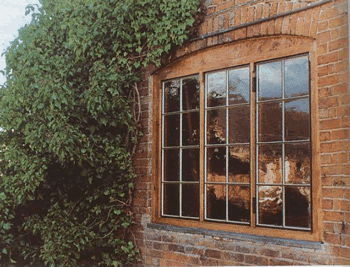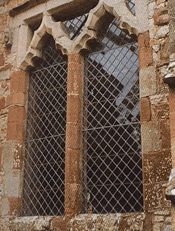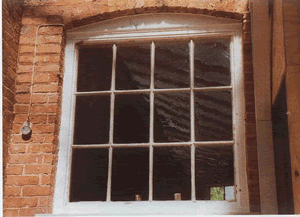Plain Glazing
Ben Sinclair
Perhaps the most noticeable and yet misunderstood feature of a historic building is that of its glass and the way that glass influences both the atmosphere and ambience of the building.
The influence of glass can be seen both internally and externally, working in a reflective and refractive capacity. Externally, the reflective quality of glass will be most noticeable, varying from the crude slab-like appearance of float glass to the subtle shimmer of period cylinder or crown glass. Internally, handmade glass will influence the softness and warmth of incoming light, as well as the appearance of external views through that glass. The difference between a cold clinical light seen through modern float glass and a warm refracted light through early Victorian cylinder glass is profound.

New cylinder glass set into restored cast iron frames
EARLY
GLASS PRODUCTION
Glass used
for glazing is made by heating together sand (silica) and lime (calcium
oxide) at a high temperature with a flux of wood ash or soda to reduce
the temperature at which the particles fuse. Modern clear float glass
is manufactured from silica (70-74%), lime (5-12%), and soda (12-16%),
varying between manufacturers.
Before the industrial revolution, furnaces used to make glass were fuelled with charcoal. The industry was nomadic because production depleted forests for fuel. Silica was taken straight from rivers or quarried sand, with little regard for contaminants. Sands often contained metal oxides which discoloured the glass, and early glasses would rarely have been pure 'white' or uncoloured. Beechwood ash, soda lime, and other materials used in the smelting process also added colour to the glass, which was most commonly green or straw coloured. Regular production of white glasses was uncommon until the early 19th century, when consistent materials became available, and more efficient coal- then later gas-fired furnaces were introduced.
It is a commonly held misconception that all historic windows were glazed with crown glass. Both cylinder (or broad) glass and crown glass methods of handmade flat glass production survived alongside each other until the 20th century, when crown glass declined into obscurity. Often harsh taxation regimes tended to promote one method over another, causing variations in production techniques in differing periods. Much mid and late 18th century glass was crown, where thin glass attracted less duty being taxed by weight. However, by the mid 19th century, glass production was again dominated by the cylinder method. Paxton's 1851 Crystal Palace was built using cylinder glass, made by Chance Bros. of Birmingham. This building used just over 80,000m2 glass, approximately one third of the English annual production at that time. Packington Hall, at Meriden in the Midlands, glazed c1840 has a good mix of both white crown and white cylinder glass. St James's Church, on the same estate, c1792 is glazed with predominantly crown glass, very active with obvious curvilinear striations, bubbles, and a straw tint.
Slab
Glass Cylinder
Glass Crown
Glass |
Polished
PlateGlass Drawn
Sheet Glass Float
Glass
|
RE-USING
HISTORIC GLASS
The
removal of historic glass from timber sash windows and cast iron frames
is fraught with difficulty, usually as a result of hard putties and rigid
frames. Where new windows are required, the original frames can be sacrificed
to save the glass for re-use, but if the frames are to be repaired, extracting
the panes requires care and a great deal of time. Even once the face putty
is removed, the thin line of putty between the glass and the frame is
usually more than enough to keep the glass immoveable. It is sensible
to leave glass in situ, reface any lost or damaged putty with new, and
refrain from disturbing surrounding framework if at all possible.
The removal of historic glass from leaded lights is not so difficult because the lead cames which support it are flexible, and all surviving glass can and should be re-used when releading historic windows. Nevertheless, there is a considerable risk of accidental damage. Loss of historic glass in the releading process is indicative of poor workmanship. Where historic glass is partially missing, then very similar glasses should be used to complement the originals. The use of float glass alongside handmade glass looks ugly and is again indicative of poor workmanship, resulting in a 'spotted dick' appearance.
MACHINE-MADE
GLASS
Float glass, due to its
flat perfection is not an appropriate alternative. Float glass that has
been distorted in a kiln has an individual appearance markedly different
to handmade glass. It is bland to view, has a 'bendy' appearance, lacks
surface brilliance, and is quite unlike handmade glass. Its use should
be discouraged, as the visual impact of this 'economy' glass on a building
is false and obvious.
Drawn sheet glass, commonly called 'horticultural', has some linear movement, though still dull and relatively lifeless. Its only advantage, along with float glass, is price. It is worth remembering that cheap glass looks exactly that: cheap.
Cathedral glass is an obscured textured rolled glass with smooth and rough faces, commonly used in lavatories. Originally hand rolled, it is now machine-made in Germany, America and China.
Pressed patterned glasses are produced in a similar fashion to cathedral glass. Some Victorian patterns are available, mainly as imports from America.
Machine-made 'antique' glass is made by wire-stroking drawn sheet glass whilst still plastic. Produced mainly for the art glass market, its busy striations make the glass artificially active.
Above: Modern float glass in a church window at Leamington Hastings. Period glass survives in the head of the window only. |
Below: A Victorian window reglazed with new cylinder glass
|
HANDMADE
GLASS ALTERNATIVES
Cylinder
glass is a handmade mouth-blown glass, readily available commercially.
There are many different types, some produced for restoration purposes,
but most are art glasses. Most handmade glass for the stained glass market
is produced by this method.
Crown glass is a handmade mouth-blown spun glass which is only available today in the form of small, heavy bullions. True crown glass replicating the fine thin crown glasses typical of the mid 19th century is unavailable, and any modern glass sold today as 'crown' glass is likely to be cylinder glass of one type or another. Fine clear handmade cylinder glass is the only compatible glass alternative today.
Care must be involved in the selection of handmade glass: there are many types of cylinder glass, and specifying that term alone is not enough. The exaggerated appearance of many contemporary types of 'antique', 'reamy' or 'seedy' cylinder glasses produced for the art glass market make them poor substitutes for historic window glass.
There are good imported glasses from Germany, France and Poland that are extremely close to old glasses that still survive, and it is these that must be sought out. There is now no handmade window glass made commercially in the UK.
CASE
STUDY: LODGE PARK The building has been recently restored under the direction of the architect Michael Reardon, in collaboration with Jeffrey Haworth of the Trust's Severn Region office, and the archaeologist Warwick Rodwell. The Glass used to glaze the 13 principal windows was purpose-made as a traditional cylinder, or broad glass. This was a deliberate attempt to replicate English cylinder glass typical of the mid 17th century, with new glass manufactured in France. Primitive surviving glasses were copied from this period, based largely on plain broad glass dated 1667 in the private church at Compton Wynyates, Tysoe, Warwickshire. Although deliberately active, straw green tinted, and with numerous bubbles, inclusions and imperfections, this glass was made as it was 350 years ago. It is not excessively distressed or over active, as a modern art glasses might appear; neither is it as perfect as a 19th century handmade cylinder, or crown glass. The colouring is typical of a glass manufactured from contaminated sands and potash within a charcoal furnace; the oxides and impurities creating a sparkling, lightly coloured and imperfect glass with tremendous life and movement. The resultant light in Lodge Park is much warmer than the clinically clear white light one might expect of a more modern building, emphasising the natural colour of fine stone, timber and lime plasterwork now found within the building. |





